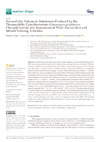Identificador persistente para citar o vincular este elemento:
https://accedacris.ulpgc.es/jspui/handle/10553/114302
| Título: | Extracellular Polymeric Substances Produced by the Thermophilic Cyanobacterium Gloeocapsa gelatinosa: Characterization and Assessment of Their Antioxidant and Metal-Chelating Activities | Autores/as: | Gongi, Wejdene Gómez Pinchetti, Juan Luis Cordeiro, Nereida Ouada, Hatem Ben |
Clasificación UNESCO: | 3302 Tecnología bioquímica 241707 Algología (ficología) 221090 Química-física de polímeros |
Palabras clave: | Gloeocapsa gelatinosa Extracellular polymeric substances Physicochemical characterization Functional properties Antioxidant activity, et al. |
Fecha de publicación: | 2022 | Proyectos: | Red de Excelencia en Biotecnología Azul (Algas) de la Región Macaronésica. Consolidación, Certificación y Transferencia Implementation and Sustainability of Microbial Resource Research Infrastructure for 21st Century |
Publicación seriada: | Marine Drugs | Resumen: | Cyanobacteria, particularly thermophilic strains, represent an important potential source of EPSs, harboring structural complexity that predicts diverse and specific bioactive potential. The thermophilic cyanobacteria Gloeocapsa gelatinosa, isolated from a natural hot source in Ain Echfa (Tunisia), was cultivated in a cylindrical reactor, and the production of biomass and EPSs was investigated. Results revealed that the strain is amongst the most efficient EPSs producers (0.89 g L−1) and that EPSs production was not correlated with the growth phase. EPSs were sulfated heteropolysaccharides containing carbohydrates (70%) based on nine different monosaccharides, mainly mannose (22%), and with the presence of two uronic acids. EPSs were formed by two polymers moieties with a molecular weight of 598.3 ± 7.2 and 67.2 ± 4.4 kDa. They are thermostable in temperatures exceeding 100 °C and have an anionic nature (zeta potential of −40 ± 2 mV). Atomic force microscopy showed that EPSs formed multimodal lumps with 88 nm maximum height. EPSs presented high water holding capacity (70.29 ± 2.36%) and solubility index (97.43 ± 1.24%), and a strong bivalent metal sorption capacity especially for Cu2+ (91.20 ± 1.25%) and Fe2+ (75.51 ± 0.71%). The antioxidant activity of G. gelatinosa EPSs was investigated using four methods: the β-carotene-bleaching activity, DPPH assays, iron-reducing activity, and metal-chelating activity. EPS has shown high potential as free radicals’ scavenger, with an IC50 on DPPH (0.2 g L−1) three-fold lower than ascorbic acid (0.6 g L −1) and as a metal chelating activity (IC50 = 0.4 g L−1) significantly lower than EDTA. The obtained results allow further exploration of the thermophilic G. gelatinosa for several biotechnological and industrial applications. | URI: | https://accedacris.ulpgc.es/handle/10553/114302 | ISSN: | 1660-3397 | DOI: | 10.3390/md20040227 | Fuente: | Marine Drugs [ISSN 1660-3397], v. 20(4), 227, (Marzo 2022) |
| Colección: | Artículos |
Citas SCOPUSTM
19
actualizado el 08-jun-2025
Citas de WEB OF SCIENCETM
Citations
17
actualizado el 08-jun-2025
Visitas
118
actualizado el 28-dic-2024
Descargas
160
actualizado el 28-dic-2024
Google ScholarTM
Verifica
Altmetric
Comparte
Exporta metadatos
Los elementos en ULPGC accedaCRIS están protegidos por derechos de autor con todos los derechos reservados, a menos que se indique lo contrario.
